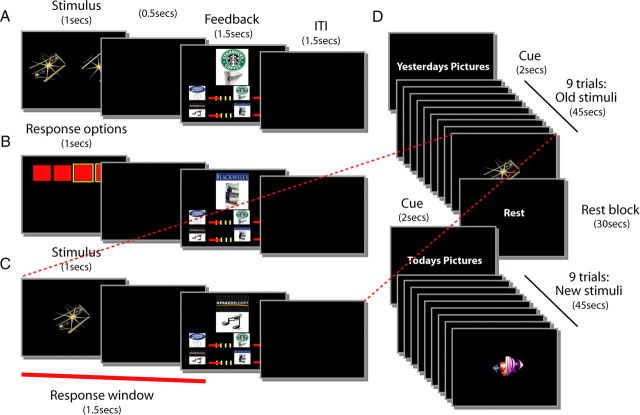Figure 1.
A–C, Schematic representation of the trial events for each stage of task learning and performance. Timing of events was analogous for all phases of the experiment. A, S–O learning task (Stage 1). A pair of stimuli were presented on the left and right of the screen for 1500 ms on each trial, and subjects attempted to identify the stimulus associated with reward. Subjects pressed one of two buttons that corresponded to the two sides of the screen. Subjects had to respond within 500 ms of stimulus offset. The presentation of a token constituted the outcome on correctly performed trials, while the presentation of a red cross indicated an error either of choice or timing. It was presented above four bars that reflected the amount of each token type that had been accumulated. The feedback screen was visible for 1500 ms and was then immediately replaced by an intertrial interval (ITI) of 1500 ms. B, Response-outcome learning (Stage 2). Four red squares corresponded to the positions of four possible button responses subjects could make. The timing was similar to that used in Stage 1; initial visual presentation of the squares lasted 1500 ms on each trial, and subjects had to respond within 500 ms of stimulus offset. As in Stage 1, the presentation of a token constituted the outcome on correctly performed trials, while the presentation of a red cross indicated an error of timing. It was presented above four bars that reflected the amount of each token type accumulated. As in Stage 1, the feedback screen was visible for 1500 ms and then immediately followed by an ITI of 1500 ms. C, S–R pair learning task (Stage 3). A single stimulus was presented and subjects had to identify which of the four possible responses was rewarded in association with each stimulus. As in Stages 1 and 2, stimulus presentation lasted 1500 ms, and subjects had to respond within 500 ms of stimulus offset; presentation of a token constituted the outcome on correctly performed trials. The presentation of a red cross indicated an error either of choice or timing. Tokens were presented above four bars that reflected the amount of each token type accumulated. As before, the feedback screen was visible for 1500 ms and then immediately followed by an intertrial interval (ITI) of 1500 ms. D, Schematic representation of the order of events in the fMRI phase of the experiment (Stage 5). Subjects learned a new set of S–R pairs (New learning task) and performed a previously learned set of S–R pairs (Old recall task) in a pseudorandom order in miniblocks of nine trials. Each miniblock lasted 45 s and was cued for 2 s with “Yesterday's Pictures” or “Today's Pictures” for old and new stimuli, respectively. Thirty second rest blocks were also interspersed within the experiment. All other events and durations were the same as in Stage 3 (C). A given stimulus or response was always associated with a specific outcome on correctly performed trials in the Consistent group. In the Inconsistent group, correctly performed trials were reward with a randomly selected outcome from the set of four possible outcomes.

